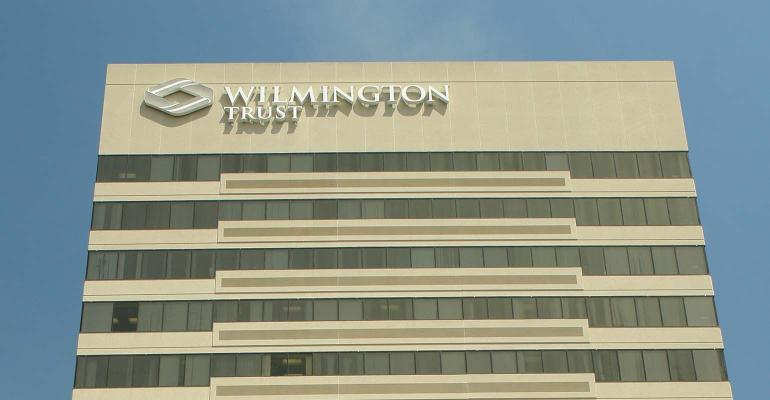One of the trends highlighted by Dani Fava, Envestnet’s Group head of product innovation, at their Elevate advisor conference last month was democratization of information and the demand for more access to products and services previously denied to the masses.
That trend has heralded what seems like an overnight and growing explosion of collective investment trusts in the RPA sold 401(k) market which in turn has led to the just closed-sale of Wilmington Trust by M&T Bank to private equity firm Madison Dearborn.
So what’s driving the tremendous growth of CITs in the RPA sold 401(k) market and why did M&T sell such a valuable and fast growing asset?
The simple answer of why CITs have garnered, for example, 79% of net inflows into target date funds last year and are likely to overtake mutual funds, according to Morningstar is cost, a big driver in the fee-sensitive defined contribution world. Not only are CITs five to 10 basis points cheaper than mutual funds due to lower compliance costs, CITs are more flexible allowing clients to negotiate investment management fees, which is why, in part, that larger 401(k) plans have been using them along for decades along with SMAs.
Previously, CITs were restricted to strategies with at least $50 million or more in a 401(k) plan due to set up costs. That dynamic changed when NFP created flexPath in 2015 in collaboration with Wilmington Trust and BlackRock, allowing RPAs with tens of billions under management to leverage their entire book and offer CITs to even the smallest plans. Fees were not just five to 10 basis points cheaper than the mutual fund they mirror but 20% or even 40% cheaper as NFP leveraged their entire book of business.
NFP and RPAG advisors with access could price out competitors. Arguably, a plan sponsor that does not use an available lower cost CIT version of a strategy could be subject to the same fiduciary liability that has driven many lawsuits that claim that a cheaper alternative was available but ignored.
These CITs also gave RPAs whose Triple F fees were under attack another source of revenue although the recent Woods lawsuit now at trial against flexPath has given other RPA aggregators reason the rethink creating proprietary funds.
And rather than complain about a drop in fees, active managers competing against low-cost index funds have been more than willing to reduce costs if they get distribution and economies of scale just like in the institutional 401(k) market. Like checkbooks, mutual funds in DC plans have become an anachronism with their relatively inflexible pricing, costly SEC and board oversight as well as imbedded 12(b)-1 fees. American Funds tried to save mutual funds with their six versions of R shares for retirement plans but CITs are more elegant and cheaper solutions.
Though CITs cannot exactly mirror their “sister” mutual fund strategies, they are close enough to avoid a three year waiting period required for most new 401(k) investments and the difficulty in reporting has been mostly overcome by Wilmington with the introduction of ticker symbols in 2019 and information sent to data providers like Morningstar.
So with CIT growth from $2 billion in 2011 when M&T Bank bought Wilmington Trust, with the main asset their wealth management advisors who will stay with the bank, to the current $129 billion and a 40% CAGR last year, according to Rob Barnett, executive vice president and head of intermediary sales distribution under M&T and now CEO, why would the bank sell?
Though a good hedge against interest rate revenue, Barnett noted that more investment was required to grow into Wilmington’s full potential, something the bank may not have wanted to do but something private equity firms relish, especially with established businesses in robust markets like 401(k) and soon to be 403(b) plans if proposed legislation passes to allow them to use CITs. Note that Madison has NFP in their portfolio, which owns a big piece of flexPath.
Barnet said investments in technology as well as acquisitions are likely for the 65 person firm that will be headquartered in Boston but the biggest opportunity may be distribution. Currently Wilmington has three external salespeople and 50 subadvisors with 600 funds.
The DCIO business, which includes 50 firms with an average of seven external wholesalers, is a tough business only getting tougher. Without a top target date strategy, index strategy or record keeper, which includes only a handful of firms, DCIOs struggle, which is why Hartford Funds reportedly let go most of their DCIO wholesalers recently.
It’s also why most DCIOs, even the handful of winners like American Funds, T Rowe Price and Fidelity have been willing to partner with flexPath, even though they are a competitor. Through their NFP and RPAG network, flexPath offers distribution for which almost every fund company is willing to pay for through discounted pricing.
Wilmington Trust, with the backing of Madison Dearborn, could become the outsourced distribution resource for their DCIO partners, especially those that struggle. Most would gladly offer 20%-40% discounted pricing like they do for flexPath especially to a firm that has access to the entire RPA distribution system, not just a relatively small subset.
With a dominant market share in the RPA sold market, plus the need for most DCIOs to increase distribution without bulking up external sales forces, the opportunity is real. Can they or will they be able to execute and develop distribution capabilities to augment what they have done with building CITs for RPAs and their clients? Stay tuned.
Fred Barstein is founder and CEO of TRAU, TPSU and 401kTV.



